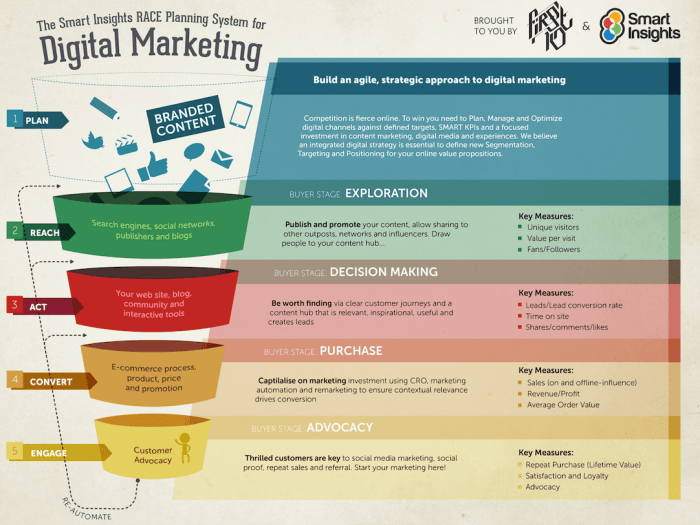Developing a Multi-Channel Marketing Plan sets the stage for a strategic approach to reaching your audience through various channels. Get ready to dive into the world of marketing strategies that will elevate your brand presence and engagement levels.
Overview of Multi-Channel Marketing Plan
In the world of marketing, a multi-channel marketing plan involves utilizing various channels and platforms to reach and engage with customers. This strategy goes beyond just one avenue, such as traditional advertising, and incorporates online platforms, social media, email marketing, and more. By diversifying the channels through which you communicate with your target audience, you can increase brand visibility, improve customer engagement, and drive conversions.
Benefits of Implementing a Multi-Channel Marketing Strategy
- Wider Reach: By utilizing multiple channels, you can reach a larger and more diverse audience.
- Increased Brand Awareness: Consistent messaging across different channels helps reinforce brand recognition.
- Improved Customer Engagement: Engaging with customers on various platforms allows for a more personalized and interactive experience.
- Enhanced Customer Experience: Providing a seamless experience across channels can improve customer satisfaction and loyalty.
- Higher Conversion Rates: By meeting customers where they are and providing relevant content, you can increase conversion rates.
Key Components of a Successful Multi-Channel Marketing Plan
- Market Research: Understanding your target audience and their preferences is crucial for crafting an effective multi-channel strategy.
- Consistent Branding: Maintaining a consistent brand image and messaging across all channels helps build brand trust and recognition.
- Channel Integration: Ensuring that all channels work together seamlessly to provide a cohesive customer experience.
- Data Analysis: Monitoring and analyzing data from different channels can help optimize marketing efforts and drive better results.
- Adaptability: Being able to adapt and adjust your strategy based on performance data and changing market trends is essential for success.
Understanding Target Audience

Understanding the target audience is crucial in multi-channel marketing as it helps businesses tailor their marketing strategies to effectively reach and engage with their potential customers. By knowing who their target audience is, businesses can create personalized and relevant content that resonates with their audience, leading to higher conversion rates and customer loyalty.
Importance of Understanding Target Audience
- Targeting the right audience increases the chances of reaching potential customers who are more likely to be interested in the products or services offered.
- Understanding the needs, preferences, and behaviors of the target audience allows businesses to create targeted marketing campaigns that are more effective and efficient.
- By knowing the target audience demographics, businesses can choose the most appropriate channels to reach them, maximizing the impact of their marketing efforts.
Examples of How Demographic Data Influences Channel Selection
- For a younger audience, social media platforms like Instagram and Snapchat might be more effective due to their popularity among this demographic.
- An older audience may respond better to traditional marketing channels like print ads or email marketing.
- Geographic data can also influence channel selection, such as using local radio ads to target customers in specific regions.
Creating Buyer Personas for Effective Targeting
- Research and gather data on your target audience to create detailed buyer personas that represent different segments of your target market.
- Include information such as demographics, interests, buying behavior, pain points, and goals in your buyer personas.
- Use these buyer personas to guide your marketing strategies and tailor your messages to resonate with each segment of your target audience.
Selecting Marketing Channels

In order to effectively reach your target audience and achieve your campaign goals, it is essential to carefully select the most suitable marketing channels. Here, we will explore various marketing channels available for multi-channel marketing, compare the advantages and disadvantages of popular options like social media, email, , and PPC, and share tips for making the best choices based on your specific needs.
Popular Marketing Channels
- Social Media:
- Advantages: Wide reach, engagement opportunities, targeted advertising options.
- Disadvantages: High competition, algorithm changes, potential for negative feedback.
- Email:
- Advantages: Direct communication, personalized messaging, cost-effective.
- Disadvantages: Risk of ending up in spam folders, declining open rates, time-consuming to manage.
- (Search Engine Optimization):
- Advantages: Increased organic traffic, long-term results, credibility and trust building.
- Disadvantages: Constant algorithm changes, slow to see results, requires ongoing effort.
- PPC (Pay-Per-Click) Advertising:
- Advantages: Immediate results, precise targeting, measurable ROI.
- Disadvantages: Costly, requires expertise, potential for click fraud.
Tips for Selecting Channels
- Understand your target audience: Research where your audience spends their time online and what type of content they engage with.
- Set clear campaign goals: Determine whether you aim to increase brand awareness, drive website traffic, generate leads, or boost sales.
- Consider channel compatibility: Choose channels that align with your brand identity, content style, and overall marketing strategy.
- Monitor and analyze performance: Track key metrics to assess the effectiveness of each channel and make data-driven decisions for optimization.
Creating Integrated Campaigns
Integrated campaigns in a multi-channel marketing plan involve coordinating and aligning various marketing channels to deliver a consistent message to the target audience. This approach ensures that the audience receives a cohesive brand experience across different touchpoints.
Ensuring Consistency Across Marketing Channels
Consistency across different marketing channels is crucial to the success of integrated campaigns. Here are some examples of how to ensure consistency:
- Create a style guide with brand elements such as logos, colors, and fonts to maintain visual consistency.
- Use the same brand voice and tone in all communication to establish a unified message.
- Coordinate messaging and content to reinforce key brand values and offerings across channels.
- Ensure seamless transitions between online and offline channels for a smooth customer journey.
Importance of a Unified Brand Message
A unified brand message is essential in integrated campaigns to build brand recognition and loyalty. Consistency in messaging helps to strengthen brand identity and establish trust with the target audience. By delivering a unified message across all touchpoints, companies can create a memorable brand experience that resonates with customers and sets them apart from competitors.
Measuring Success and ROI
In order to gauge the effectiveness of a multi-channel marketing plan, it is essential to track key metrics and calculate the Return on Investment (ROI) for each marketing channel. By analyzing data and optimizing campaigns based on performance metrics, businesses can ensure the success of their marketing efforts.
Key Metrics for Tracking Success, Developing a Multi-Channel Marketing Plan
- Conversion Rate: Measure the percentage of website visitors who take a desired action, such as making a purchase or signing up for a newsletter.
- Customer Acquisition Cost (CAC): Calculate the average cost to acquire a new customer across all marketing channels.
- Customer Lifetime Value (CLV): Determine the total revenue a customer is expected to generate over their lifetime as a customer.
- Engagement Metrics: Track metrics like click-through rates, time spent on site, and social media interactions to assess customer engagement.
Calculating ROI for Each Marketing Channel
ROI = (Revenue – Cost) / Cost
Calculating ROI for each marketing channel involves comparing the revenue generated against the costs incurred to determine the profitability of that specific channel. By analyzing ROI for each channel, businesses can allocate resources more effectively to maximize their return on investment.
Analyzing Data and Optimizing Campaigns
Utilizing tools like Google Analytics, CRM systems, and marketing automation platforms, businesses can analyze data to gain insights into customer behavior and campaign performance. By leveraging A/B testing, heatmaps, and segmentation techniques, marketers can optimize campaigns based on performance metrics to improve overall effectiveness.
Adapting to Changing Trends: Developing A Multi-Channel Marketing Plan
In the fast-paced world of multi-channel marketing, staying ahead of emerging trends is crucial for success. As consumer behaviors evolve, businesses must be flexible and adaptive to remain competitive in the market. Here are some strategies to help you adapt to changing trends:
Embracing New Technologies
Incorporating the latest technologies into your marketing strategy can give you a competitive edge. Whether it’s leveraging AI for personalized recommendations or utilizing AR/VR for interactive experiences, experimenting with new tools can help you connect with your target audience in innovative ways.
Omnichannel Integration
With consumers engaging across multiple channels, it’s important to create a seamless experience across all touchpoints. By integrating your channels and providing consistent messaging, you can ensure a cohesive brand experience that resonates with your audience, regardless of where they interact with your brand.
Data-Driven Decision Making
Utilize data analytics to track the performance of your marketing campaigns and understand consumer preferences. By analyzing data insights, you can identify trends, optimize your strategies, and make informed decisions about which channels are most effective for reaching your target audience.
Agile Marketing Approach
Embrace an agile marketing approach that allows you to quickly pivot and adjust your strategies based on changing trends. By staying nimble and responsive to market shifts, you can adapt your campaigns in real-time to meet the evolving needs and expectations of your audience.
Case Studies and Best Practices
In this section, we will delve into real-world case studies of successful multi-channel marketing campaigns and share best practices for implementing and managing a multi-channel marketing plan effectively. Let’s explore key takeaways from successful multi-channel marketing strategies in various industries.
Case Study 1: Nike’s “Just Do It” Campaign
Nike’s “Just Do It” campaign is a classic example of a successful multi-channel marketing strategy. By combining traditional advertising, social media engagement, influencer partnerships, and experiential marketing, Nike was able to create a cohesive brand message that resonated with its target audience. The campaign not only boosted brand awareness but also drove sales and customer loyalty.
- Utilized traditional advertising channels like TV commercials and print ads to reach a wide audience.
- Engaged with consumers on social media platforms like Instagram and Twitter to spark conversations and build brand affinity.
- Collaborated with athletes and celebrities to create authentic and impactful content that inspired consumers.
- Hosted experiential marketing events and pop-up shops to provide immersive brand experiences for customers.
Key Takeaway: Nike’s multi-channel marketing approach demonstrates the power of integrating various channels to create a consistent brand message and engage with consumers on different touchpoints effectively.
Best Practices for Multi-Channel Marketing
When implementing a multi-channel marketing plan, it is essential to follow certain best practices to ensure success. Here are some key tips to keep in mind:
- Understand your target audience across different channels to tailor your messaging effectively.
- Consistently monitor and analyze data from each channel to optimize performance and make data-driven decisions.
- Ensure seamless integration between channels to provide a cohesive customer experience.
- Experiment with new channels and technologies to stay ahead of trends and reach your audience innovatively.
Key Takeaway: By following best practices and staying agile in adapting to changing trends, businesses can create impactful multi-channel marketing campaigns that drive results across various industries.